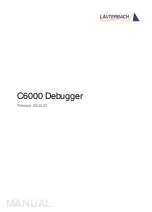
15
E3FZ/E3FR
Safety precautions
This product is not designed or rated for directly or
indirectly ensuring safety of persons. Do not use it for
such a purpose.
Do not use the product with voltage in excess of the
rated voltage. Excess voltage may result in malfunc-
tion or fire.
Never use the product with an AC power supply.
Otherwise, explostion may result.
When cleaning the product, do not apply a high-pres-
sure spray of water to one part of the product. Other-
wise, parts may
b
ecome damaged and the degree of
protection may
b
e degraded.
High-temperature environments may result in
b
urn
injury.
The following precautions must
b
e o
b
served to ensure safe
operation of the Sensor.
Operating Environment
Do not use the Sensor in an environment where explosive or
flamma
b
le gas is present.
Connecting Connectors
Be sure to hold the connector cover when inserting or removing
the connector. Be sure to tighten the connector lock
b
y hand;
do not use pliers or other tools. If the tightening is insufficient, the
degree of protection will not
b
e maintained and the Sensor may
b
ecome loose due to vi
b
ration. The appropriate tightening tor
q
ue
is 0.
3
9 to 0.49 N·m for M12 connectors.
Load
Do not use a load that exceeds the rated load.
Rotation Tor
q
ue for Sensitivity Adjustment
Adjust with a tor
q
ue of 0.05 N·m or less.
Environements with Cleaners and Disinfectants
(e.g., Food Processing Lines)
Do not use the Sensor in environments su
b
ject to cleaners and
disifectants. They may reduce the degree of protection.
Modifications
Do not attempt to disassem
b
le, repair, or modify the Sensor.
Outdoor Use
Do not use the Sensor in locations su
b
ject to direct sunlight.
Cleaning
Do not use thinner, alcohol, or other organic solvents. Otherwise,
the optical properties and degree of protection may
b
e degraded.
Surface Temperature
Burn injury may occur. The Sensor surface temperature rises de-
pending on application conditions, such as the surrounding tem-
perature and the power supply voltage. Use caution when
operating or washing the Sensor.
Do not use the Sensor in any atmosphere or environment that
exceeds the ratings.
Do not install the Sensor in the following locations.
(1) Locations su
b
ject to direct sunlight
(2) Locations su
b
ject to condensation due to high humidity
(
3
) Locations su
b
ject to corrosive gas
(4) Locations where the Sensor may receive direct vi
b
ration or
shock
Connecting and Mounting
(1) The maximum power supply voltage is
3
0 VDC. Before turning
the power ON, make sure that the power supply voltage does
not exceed the maximum voltage.
(2) Laying Sensor wiring in the same conduit or duct as high-volt-
age wires or power lines may result in malfunction or damage
due to induction. As a general rule, wire the Sensor in a sepa-
rate conduit or use shielded ca
b
le.
(
3
) Use an extension ca
b
le with a minimum thickness of 0.
3
mm
2
and less than 100 m long.
(4) Do not pull on the ca
b
le with excessive force.
(5) Pounding the Photoelectric Sensor with a hammer or other
tool during mounting will impair water resistance.
(6) Mount the Sensor either using the
b
racket (sold separately) or
on a flat surface.
(7) Be sure to turn OFF the power supply
b
efore inserting or re-
moving the connector.
Cleaning
Never use thinner or other solvents. Otherwise, the Sensor sur-
face may
b
e dissolved.
Power Supply
If a commercial switching regulator is used, ground the FG (frame
ground) terminal.
Power Supply Reset Time
The Sensor will
b
e a
b
le to detect o
b
jects 100 ms after the power
supply is tuned ON. Start using the Sensor 100 ms or more after
turning ON the power supply. If the load and the Sensor are con-
nected to separate power supplies,
b
e sure to turn ON the Sensor
first.
Turning OFF the Power Supply
Output pulses may
b
e generated even when the power supply is
OFF. Therefore, it is recommended to first turn OFF the power
supply for the load or the load line.
Load Short-circuit Protection
This Sensor is e
q
uipped with load short-circuit protection,
b
ut
b
e
sure to not short circuit the load. Be sure to not use an output cur-
rent flow that exceeds the rated current. If a load short circuit oc-
curs, the output will turn OFF, so check the wiring
b
efore turning
ON the power supply again. The short-circuit protection circuit will
b
e reset. The load short-circuit protection will operate when the
current flow reaches 1.8 times the rated load current. When using
a capacitive load, use an inrush current of 1.8 times the rated load
current or higher.
Water Resistance
Do not use the Sensor in water, rainfall, or outdoors.
!
Warning
!
Caution
Precautions for Safe Use
Precautions for Correct Use
E55E-EN-01+E3FZ-E3FR+Datasheet.FM Seite 15 Dienstag, 15. April 2008 5:17 17


































